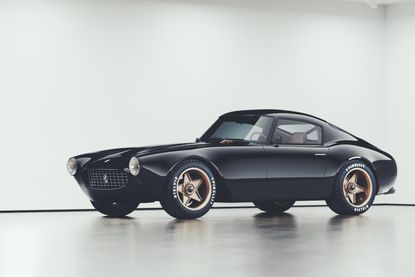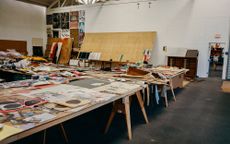Competizione Ventidue is a concept restomod blending Ferrari style with hydrogen power
Forge Design has created the Competizione Ventidue, a contemporary interpretation of an iconic 1960s Ferrari inspired by the decade’s art, music and architecture
- (opens in new tab)
- (opens in new tab)
- (opens in new tab)
- Sign up to our newsletter Newsletter

There’s a seemingly endless desire for bespoke automobiles inspired by classic designs. Such ‘restomods’ are in near constant demand, whether they’re based on stripped-down and rebuilt originals or start from a clean sheet using some direct inspiration (see the Porsche-inspired 928 by Nardone Automotive).

This is the Competizione Ventidue: a hydrogen-fuelled, high performance, Ferrari restomod concept created by London-based design studio Forge Design. Right now, it’s only a concept, inspired in part by a bit of creative reimagining and alternative history-making.
‘We wanted to reimagine the car that Miles Davis might have bought just after his album dropped,’ says Kieran Singleton, Forge Design’s managing director. ‘He was a huge Ferrari fan and loved driving fast in beautiful cars; this is imagined as the car he bought, enjoyed, upgraded and perhaps even raced.’

The source material – in addition to Davis’ music – is the 1961 Ferrari 250 SWB, in particular the highly refined ‘SEFAC Hot Rod’ variant, with ultra-light aluminium bodywork and a boosted engine. The car was a class-winner at Le Mans in 1961, helping solidify the 250’s status as the ultimate classic car investment (examples sell at auction for upwards of $8m).
Perhaps mindful of the hefty investment needed to get its venture off the ground, Forge Design has gone all-out for technologies that haven’t yet hit the mainstream. These include a hydrogen-burning engine and composite bodywork.

Ventidue (‘22’ in Italian) is more attuned to the last days of the 1950s, with the designers citing 1959 as the year of peak inspiration. This was when the Ferrari 250 GT Berlinetta SWB was launched at the Paris Motor Show (the racing car’s ‘spiritual ancestor’), the year Frank Lloyd Wright’s posthumous masterpiece, the New York Guggenheim, opened its doors, and the year Davis’ Kind of Blue was released.

‘We’ve always loved the classic lines of the Ferrari 250 GT SWB, and after seeing a growth in the number of restomod projects recently, really wanted to have a go at our own,’ says Forge’s design director David Seesing. The studio is using the concept to promote its skills at conceptual design, rendering, and modelling.
The Ventidue makes for a striking calling card, but it’s not the only 250 GT SWB restomod out there – British specialist manufacturer RML can build a bespoke ‘Short Wheelbase’ right now, for around £1.6m.

WeForge.design (opens in new tab)
CompVentidue.com (opens in new tab)
RMLGroup.com (opens in new tab)
Jonathan Bell has written for Wallpaper* magazine since 1999, covering everything from architecture and transport design to books, tech and graphic design. He is now the magazine’s Transport and Technology Editor. Jonathan has written and edited 15 books, including Concept Car Design, 21st Century House, and The New Modern House. He is also the host of Wallpaper’s first podcast.
-
 Last chance to see: Sterling Ruby’s ‘Turbines’ at Gagosian New York, marked here by our visit to the artist’s LA studio
Last chance to see: Sterling Ruby’s ‘Turbines’ at Gagosian New York, marked here by our visit to the artist’s LA studioStep inside American artist Sterling Ruby’s studio, divided into distinct areas of operation
By Hunter Drohojowska-Philp • Published
-
 The Fendi factory in Tuscany disappears into the landscape
The Fendi factory in Tuscany disappears into the landscapeThe new Fendi Factory in Italy, set in the rolling hills of Tuscany, is the brainchild of Milan architecture studio Piuarch and the luxury brand
By Ellie Stathaki • Published
-
 Senegal’s Mamy Tall on city planning, bioclimatic construction and heritage
Senegal’s Mamy Tall on city planning, bioclimatic construction and heritageMamy Tall from Senegal is part of our series of profiles of architects, spatial designers and builders shaping West Africa's architectural future
By Ellie Stathaki • Published


